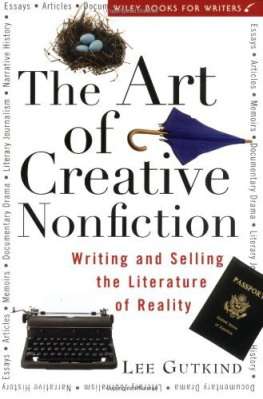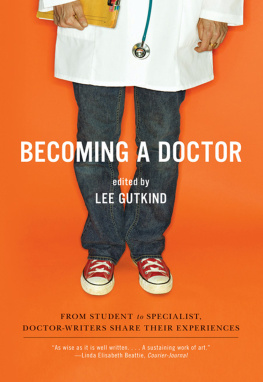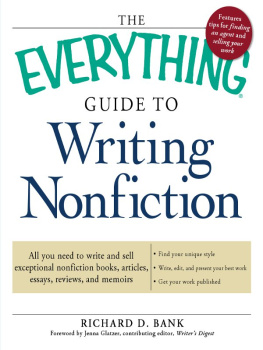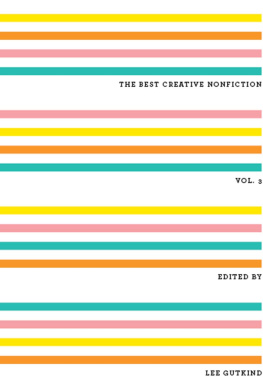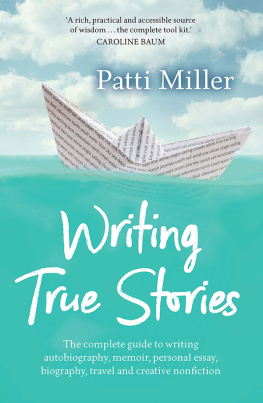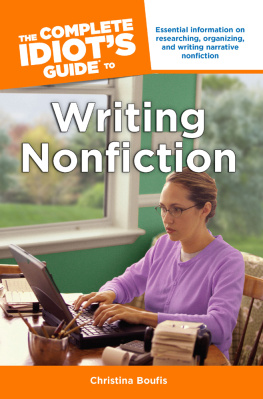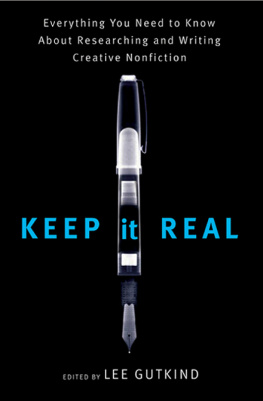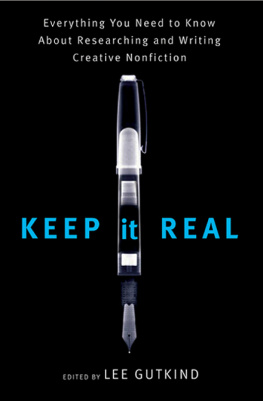Gutkind - The Art of Creative Nonfiction: Writing and Selling the Literature of Reality
Here you can read online Gutkind - The Art of Creative Nonfiction: Writing and Selling the Literature of Reality full text of the book (entire story) in english for free. Download pdf and epub, get meaning, cover and reviews about this ebook. year: 1997, publisher: Wiley, genre: Art. Description of the work, (preface) as well as reviews are available. Best literature library LitArk.com created for fans of good reading and offers a wide selection of genres:
Romance novel
Science fiction
Adventure
Detective
Science
History
Home and family
Prose
Art
Politics
Computer
Non-fiction
Religion
Business
Children
Humor
Choose a favorite category and find really read worthwhile books. Enjoy immersion in the world of imagination, feel the emotions of the characters or learn something new for yourself, make an fascinating discovery.
The Art of Creative Nonfiction: Writing and Selling the Literature of Reality: summary, description and annotation
We offer to read an annotation, description, summary or preface (depends on what the author of the book "The Art of Creative Nonfiction: Writing and Selling the Literature of Reality" wrote himself). If you haven't found the necessary information about the book — write in the comments, we will try to find it.
A complete guide to the art and craft of creative nonfiction--from one of its pioneer practitioners
The challenge of creative nonfiction is to write the truth in a style that is as accurate and informative as reportage, yet as personal, provocative, and dramatic as fiction. In this one-of-a-kind guide, award-winning author, essayist, teacher, and editor Lee Gutkind gives you concise, pointed advice on every aspect of writing and selling your work, including:
Guidelines for choosing provocative--and salable--topics
Smart research techniques--including advice on conducting penetrating interviews and using electronic research tools
Tips for focusing and structuring a piece for maximum effectiveness
Advice on working successfully with editors and literary agents
This book is for the beginning creative nonfiction writer--one who needs to be told that writers are an eccentric lot; one who has never heard of the Yaddo artists colony. Still, Lee Gutkind, the author of several books of creative nonfiction and the founder/editor of the journal Creative Nonfiction, has some interesting things to tell us about this genre of writing, which strives to communicate real-life stories dramatically. The most important quality that a creative nonfiction writer can have, writes Gutkind, is passion: A passion for the written word; a passion for the search and discovery of knowledge; and a passion for ... understand[ing] intimately how things in this world work. Gutkind offers instruction on finding story ideas, focusing ones work, keeping story files, fact checking, and interviewing; he tells us what to expect from editors and agents; and he teaches us how to know when were ready to start writing (when you can think of nothing more to ask or to learn). Perhaps the best tidbit here is Gutkinds emphasis on delving deeply into ones subject matter without inserting oneself into the situation. While immersing myself in a writing project, he says, I routinely like to compare myself to a rather undistinguished and utilitarian end table in a living room or office. It is a fixture. You walk in and out of your living room dozens of times a day. You see the table, you expect to see the table, but you do not say, Well, there is the table, hello table. Appendices include a sample book proposal and readings.
From the PublisherA pioneer in the writing and teaching of nonfiction presents a practical guide to composing creative nonfiction that covers the entire process--from initial psychological preparation to marketing a finished piece. Written in an engaging style, the book provides pertinent information on conducting research, using interviews, immersion journalism, cinematic writing, the ethical and moral concerns of writing subjective truth and more. Features examples culled from the authors journal, Creative Nonfiction, to illustrate writing techniques.
Gutkind: author's other books
Who wrote The Art of Creative Nonfiction: Writing and Selling the Literature of Reality? Find out the surname, the name of the author of the book and a list of all author's works by series.

